|
Mobile
DTV, "Smart TV" Take Center Stage at 2011 International
CES
Last week
the focus of the consumer technology world was on Las Vegas and
the annual International Consumer Electronics Show (CES, www.cesweb.org).
Digital TV technology was front and center as was the proliferation
of tablet computers which were perhaps the newest rage, virtually
nonexistent at last year's show. The three most interesting and
exciting DTV developments were in the areas of mobile DTV, "Smart
TV," and 3D.
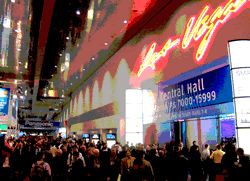 Mobile
DTV TechZone
- the center of focus for new mobile DTV technology, this special
area was located in the Las Vegas Convention Center Central Hall
and sponsored by the Open Mobile Video Coalition (OMVC, www.openmobilevideo.com).
A wide assortment of new products and technology demonstrations
were featured including: Mobile
DTV TechZone
- the center of focus for new mobile DTV technology, this special
area was located in the Las Vegas Convention Center Central Hall
and sponsored by the Open Mobile Video Coalition (OMVC, www.openmobilevideo.com).
A wide assortment of new products and technology demonstrations
were featured including:
LG and Harris
demonstrated the world's first Mobile DTV broadcast of 3D TV,
to an LG handheld mobile DTV receiver, with no glasses needed
("autostereoscopic"). LG and Harris also demonstrated
"non-real time" data transmission of electronic coupons
from a TV station to a mobile phone equipped with Mobile DTV reception
capability;
The Tivizen
iUS-100 mobile DTV receiver, from Korean manufacturer Valups,
plugs into Apple iPad, iPhone, and iTouch devices. This will reportedly
be available for consumers this June at a cost of $99;
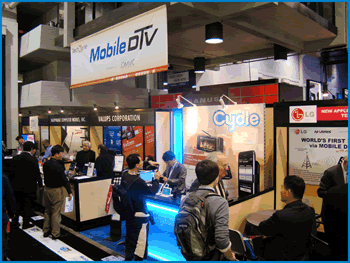 Winegard's
cioTV, with the industry's largest (10.2") display for the
automobile; Winegard's
cioTV, with the industry's largest (10.2") display for the
automobile;
New USB receivers
from DTVinteractive and Hauppauge ComputerWorks;
iPhone Mobile
DTV reception and new tablets from Cydle;
Mobile Digital
TV Wi-Fi stations from iMovee and Crestech;
Exhibits
by the mobile DTV consortia Mobile Content Venture and the Mobile500
Alliance, which together represent hundreds of broadcast stations,
demonstrating services and discussing 2011 launch plans for Mobile
DTV.
A number of local broadcasters in the Las Vegas area were supporting
the mobile DTV exhibits at CES including stationsKLAS, KLVX, KVMY,
KCVW, and KBL.
OMVC
Mobile DTV Consumer Showcase - at CES, OMVC released results
from a Consumer Showcase of Mobile DTV technology conducted
in May through October 2010, with nearly 350 consumers getting
"hands on" opportunities to use mobile DTV on prototype
cell phones, netbooks and a DVD 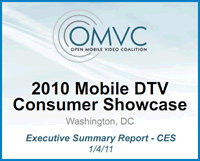 player
equipped with mobile DTV capability. A comprehensive presentation
and white paper about the OMVC Consumer Showcase results is
available online at www.tinyurl.com/ShowcaseResults.
Among the findings: player
equipped with mobile DTV capability. A comprehensive presentation
and white paper about the OMVC Consumer Showcase results is
available online at www.tinyurl.com/ShowcaseResults.
Among the findings:
Strong
consumer interest - the majority of Showcase participants
maintained a high level of excitement about mobile DTV throughout
the duration of the Showcase and were interested in continuing
to receive the service going forward;
Live, local news ranks highly - Showcase participants
found themselves tuning into their battery-powered mobile DTV
devices when storms knocked out power to their home TVs or when
breaking news unfolded while they were on-the-go. Local stations
were considered essential to the mobile DTV viewing experience,
but participants also liked having a variety of programming.
Data shows more than 30 different program genres were viewed
on the 23 available channels during the Showcase;
Mobile
DTV means more TV - Showcase research suggests that mobile
DTV will result in a net gain in overall TV consumption. 94%
of viewers reported watching more or the same amount of TV as
before. The average daily viewer spent 50 minutes watching mobile
DTV and tuned in more than twice during the day.
"Smart
TV" Products Abound - virtually every major TV manufacturer
had numerous and extensive displays in their booths on Internet-connected
Smart TVs, which provide for a multitude of services over both
traditional (broadcast, cable, satellite) channels and by Internet
delivery. The photos below, taken at the LG, Sony, Panasonic
and Samsung booths, serve to highlight the variety of offerings
as well as the different approaches and user interfaces being
adopted by the various manufacturers. While most of the products
on display had the Internet connectivity built-in to the set,
LG was displaying the ST-600 Upgrader which allows viewers to
transform their regular, non-Internet connected TV into a smart
TV. The ST-600 will provide access to all of LG's Smart TV functions
including premium online content, "Smart Share" and
all of the LG TV "apps." LG is expected to have this
new device available to consumers in the second quarter of 2011.
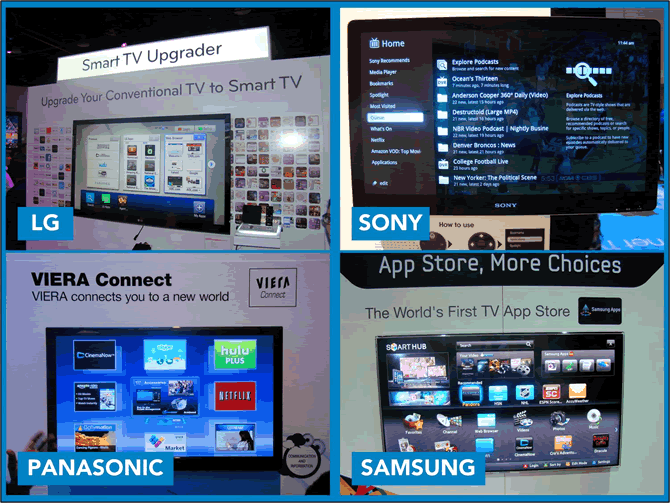
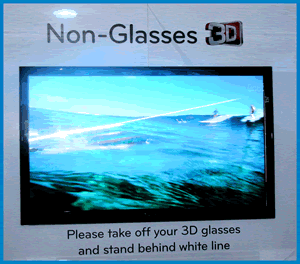 Autostereoscopic
3D TV - significant advances have been made since last year's
CES in "no glasses" 3D TV display technology (known
more formally as "autosteroscopic," in contrast to
the more common "stereoscopic" 3D TV technology which
requires the viewer to wear special 3D glasses). Shown in the
photo to the right is a prototype 55-inch LG autostereoscopic
display which had impressive 3D image quality and a much larger
"sweet spot" for 3D viewing than have previous implementations
of this technology. Major autostereoscopic exhibits were also
found in the Toshiba and Sony booths. Sony was displaying a
prototype 10.1 inch glasses-free portable 3D Blu-ray disc player
as well as larger screen displays and a 3D "headset"
which provided individual displays for left and right eyes. Autostereoscopic
3D TV - significant advances have been made since last year's
CES in "no glasses" 3D TV display technology (known
more formally as "autosteroscopic," in contrast to
the more common "stereoscopic" 3D TV technology which
requires the viewer to wear special 3D glasses). Shown in the
photo to the right is a prototype 55-inch LG autostereoscopic
display which had impressive 3D image quality and a much larger
"sweet spot" for 3D viewing than have previous implementations
of this technology. Major autostereoscopic exhibits were also
found in the Toshiba and Sony booths. Sony was displaying a
prototype 10.1 inch glasses-free portable 3D Blu-ray disc player
as well as larger screen displays and a 3D "headset"
which provided individual displays for left and right eyes.
NAB Participates
in Tech Policy Summit - NAB Sr. Vice President, Science
and Technology Lynn Claudy was a panelist at the CES Tech Policy
Summit conference held on Friday, January 7. This panel (shown
in the photo below), consisting of Mr. Claudy, Paula Boyd, Regulatory
Counsel with Microsoft Corporation, Rebecca Hanson, Senior Advisor,
Broadcast Spectrum with the FCC and Tom Wheeler, Managing Director
of Core Capital Partners and recently appointed Chair of the
FCC's Technological Advisory Council, engaged in a lively debate
regarding the FCC's National Broadband Plan and various issues
surrounding the Commission's plan to reclaim TV band spectrum
for use by mobile broadband service providers. Opening this
panel with introductory remarks was former Congressman Rick
Boucher (D-VA, shown at the podium in the photo) who until recently
represented Virginia's 10th Congressional District and served
as Chairman of the House Energy and Commerce Committee's Subcommittee
on Communications, Technology and the Internet.
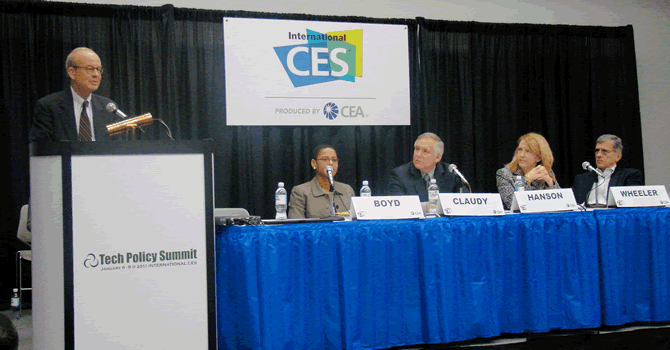
|

